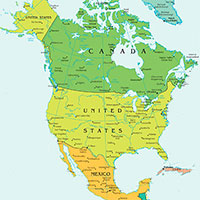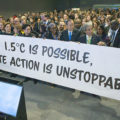The Long Road to Safety
Forrest Watkins | November 18, 2016.
Coming out of the 2015 climate negotiations, the Paris Agreement encouraged countries to set mid-century targets for emissions reductions and to establish long-term strategies by 2020 to achieve them. Civil society groups have already hailed the early release of these plans as important signals of climate leadership, but they have also criticised moderate ambition and reliance on unproven technologies.
Each plan describes a set of key areas for overall emissions reductions, as well as practical ways to reduce emissions. During this joint press conference Brian Deese, a senior advisor to US president Barack Obama, acknowledged the uncertainties stemming from technological development and climate feedback loops. But the point, he said, was not to predict the world in 2050.
“This is a long-term vision. Just like any good business has a near-term business plan, but also a broader vision for the future,” said Deese. “A vision isn’t sufficient, but without a vision, you’re missing a necessary component for action.”
The maps should be a signal to investors about long-term shifts in the economy, added Dr. Stephen Lucas, who worked on the Canadian government’s strategy. “It helps to drive research and innovation to lower the costs of transitioning,” said Lucas.
Canada has not yet submitted its plan to the UN climate change secretariat, but Lucas elaborated on its important features: land use change, developing new and less expensive clean technologies, and efficiency-boosting alterations to transport systems and urban space.
The United States offered a similar plan, concentrated largely on efficiency increases, overhauling the electrical grid, and land use changes. Deese points out that the lowest-cost emissions reduction pathways involved continued heavy investment in research and development, as well as forest regrowth encompassing one-third of the area deforested since 1850. This assumes successive White House administrations will maintain emissions reductions as a priority.
“The low-emissions pathway is unambiguously the most pro-growth, pro-jobs, pro-income, pro-American families strategy in the long-term. When you model out alternative approaches, do-nothing approaches, or high carbon development approaches, what you see is that the costs rack up, in terms of lower economic growth and less income growth for middle-class families,” Deese argues.
While the United States and Canada’s strategies put their future emissions on the high side of their responsible contribution to a low-carbon future, Mexico’s is well within a responsible range. Mexico also paid great attention to strategies for adapting to climate change. This was not specifically requested in the Paris Agreement, but undersecretary of the Mexican ministry of environment and natural resources Rodolfo Lacy Tamayo says the government wanted to increase the resilience of Mexican communities and approach climate change at a systems level, addressing environmental issues with a unified strategy.
According to analysis by Climate Interactive, the result of the three plans would avoid six per cent of global warming that would have otherwise occurred under previous plans.
North American leaders also point to the example of collaboration this process has set. “I would encourage greater collaboration between and among countries,” said Deese. “Our team found that our engagement with our Mexican and Canadian counterparts to be very valuable in working to make this vision more concrete.”
The American government plans to release the model it used for its emissions reduction scenarios, while Lucas and Lacy expressed their interest in more practical collaborations, such as links between the countries’ grids, transportation systems, and carbon markets.
Cementing this intention is Thursday’s announcement of the 2050 Pathways Platform, a website countries can use to share ideas, strategies, data and models and set up collaborations. Minister Mattlan Zackhras of the Marshall Islands said the platform would help developing countries form their long-term strategies: “We do also play a role, and want to support you in developing our own strategy. We believe that with the right combination of countries and partners, we can.”













comment